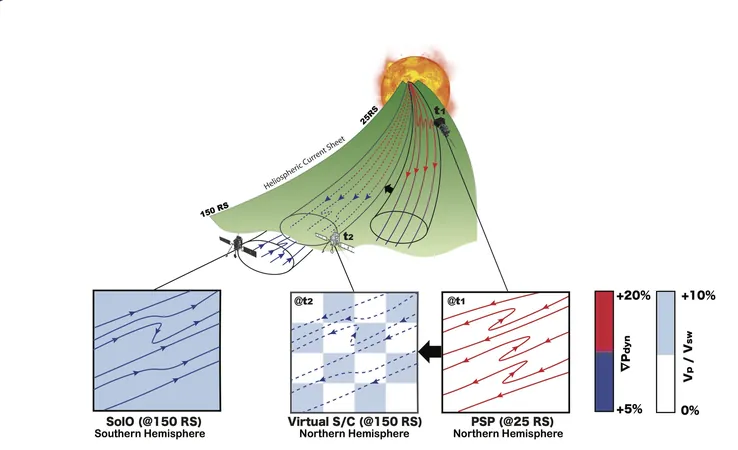
Solar Probes Unveil Secrets of Solar Wind Acceleration: A Groundbreaking Discovery
2024-12-19
Author: Ming
Introduction
In an exciting breakthrough for solar science, researchers have captured crucial data on how the sun's magnetic field propels solar wind, thanks to the alignment of two key space probes. This study, led by the University of Michigan and published in The Astrophysical Journal, provides a deeper understanding of magnetic switchbacks—sharp S-shaped bends in the magnetic fields that emanate from the sun.
Significance of Magnetic Switchbacks
These switchbacks are not just fascinating phenomena; they have significant implications for space weather, influencing the streams of charged particles, or plasma, that can disrupt electrical grids, satellites, and communication systems on Earth. The new insights are set to enhance the predictive capabilities of solar wind forecasts, allowing us to better prepare for potential impacts of space weather.
Observation and Findings
“This is the first time we have directly observed the behavior of switchback magnetic energy as it diminishes with distance from the sun,” said Shirsh Soni, a research fellow at the University of Michigan. This momentous study involved twelve instances where the Parker Solar Probe, stationed within 30 solar radii of the sun, and the Solar Orbiter, located at 130 solar radii, synchronized to collect vital data.
Transformation of Switchback Structure
By analyzing magnetic field and plasma momentum measurements from both spacecraft, researchers noticed a remarkable transformation in the switchback structure. They observed that these bundles of magnetic anomalies transitioned into smoother microstreams, showing a reduction of magnetic reversals by 30% and a 10% increase in proton velocity—signs that the solar wind is accelerating.
Magnetic Relaxation
The key to this phenomenon is identified as magnetic relaxation, where high-energy switchbacks convert magnetic energy into kinetic energy as they move outward into space. While magnetic switchbacks have been dismissed as a reason for the sun's perplexingly hot corona, they may hold the key to understanding how the solar wind gains energy as it travels through the cosmos.
Collaborative Research
“By combining the data from the Parker Solar Probe and Solar Orbiter, we can further unravel the complexities of solar wind dynamics,” Soni added, emphasizing the collaboration's significance for advancing solar physics.
Understanding Solar Activity
Mojtaba Akhavan-Tafti, a U-M associate research scientist, highlighted that magnetic switchbacks are like fingerprints of the sun’s energetic activities, reflecting its profound influence on the solar system.
Future Directions
This significant discovery paves the way for future research that could lead to improvements in space weather forecasting and our understanding of the solar system's dynamics. Researchers aim to determine the conversion of magnetic energy and its potential to generate thermal energy as well.
Conclusion
As humanity looks toward the stars, discoveries like these remind us of the intricate connections between solar activity and our everyday lives on Earth. Buckle up; the mysteries of our sun continue to unravel, promising a thrilling journey ahead!
 Brasil (PT)
Brasil (PT)
 Canada (EN)
Canada (EN)
 Chile (ES)
Chile (ES)
 España (ES)
España (ES)
 France (FR)
France (FR)
 Hong Kong (EN)
Hong Kong (EN)
 Italia (IT)
Italia (IT)
 日本 (JA)
日本 (JA)
 Magyarország (HU)
Magyarország (HU)
 Norge (NO)
Norge (NO)
 Polska (PL)
Polska (PL)
 Schweiz (DE)
Schweiz (DE)
 Singapore (EN)
Singapore (EN)
 Sverige (SV)
Sverige (SV)
 Suomi (FI)
Suomi (FI)
 Türkiye (TR)
Türkiye (TR)